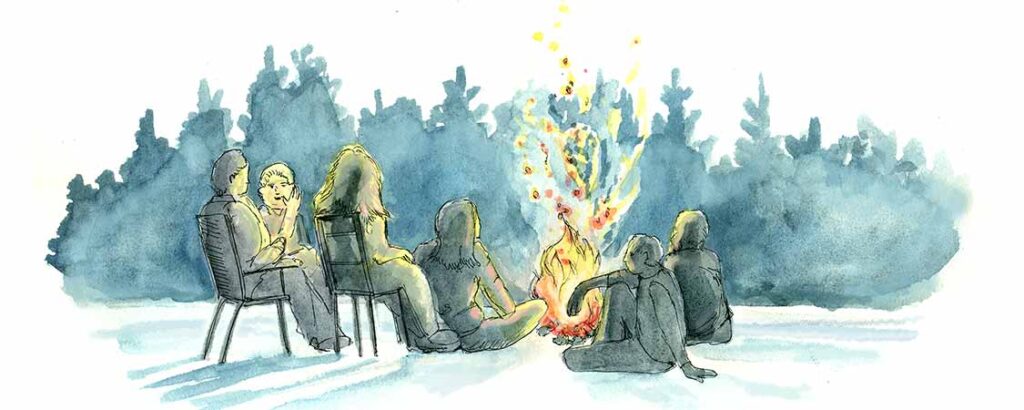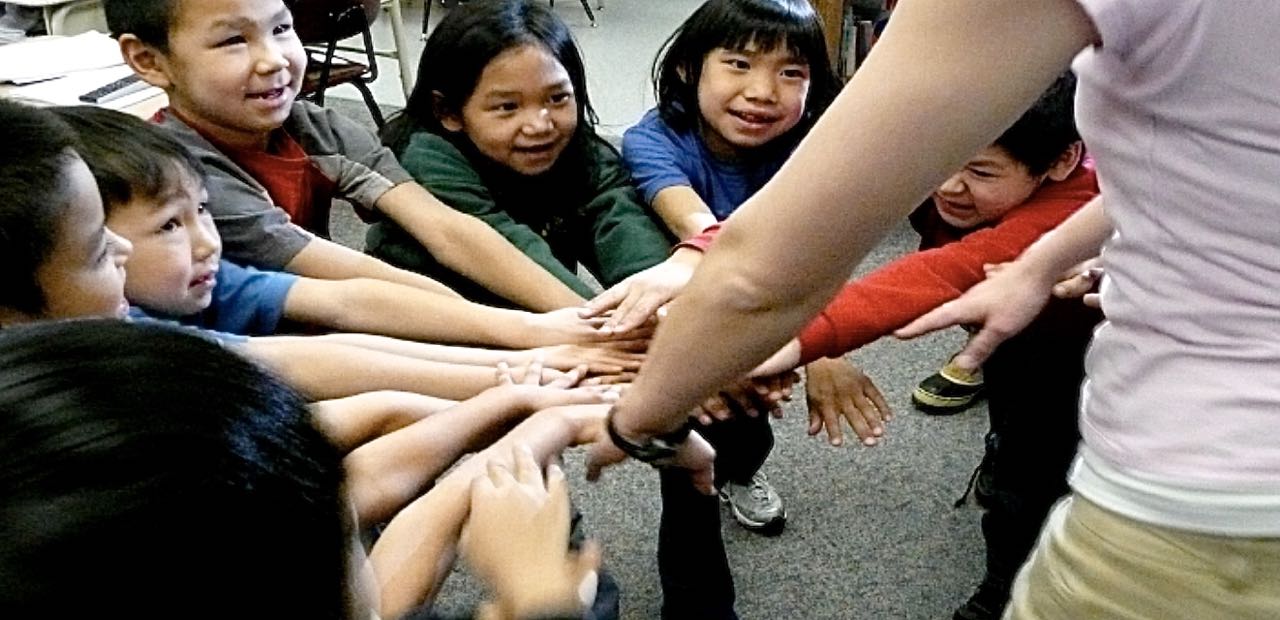
Take care of yourself, take care of others.
First Alaskans Institute
What is this section about?

Tending to one’s own health and wellness is a critical aspect of trauma-engaged practice. Self-care practices can help adults avoid secondary trauma and burnout, while providing support and positive role modeling for students.
Self Care definition
This section supports the Transforming Schools framework and includes how to build capacity within school districts to promote, provide and support self-care that is intentional, effective, and cohesive for staff.
Community adaptations
The content of this chapter is offered to district leaders, school staff, counselors, and community members with the idea that each of these people have different roles in the process of transforming schools. The intention is to support educators, with an understanding that some content needs to be adapted to make the practices culturally relevant and to align with each community’s strengths, norms, and expectations.
Trauma Engaged Schools Knowing to Doing Video Library
The Trauma Engaged Video Library offers over 50 peer-led and statewide experts short videos tied to the topics in the Framework. They are under 10 minutes and easily accessible for personal review or in a group setting to stimulate discussion. Below is the video series for this chapter.
Click on the banner on the top left of the video screen to see the chapter video titles.
What Can Leadership Do?
Click each section below for more info.
A. Lead by example. Practice self-care and wellness in visible ways in your community to show your support to students, staff, and families taking care of themselves.
- Developing a self-care plan
Guidance on developing a self care plan. A downloadable template is included on the site.
- 21 Self-Care Resources to Help You Heal and Survive
A website from the Rockwood Leadership Institute, this social justice-oriented site provides resources to help support a variety of populations.
B. Train staff to recognize signs of compassion fatigue or secondary trauma, and to understand that self-care is necessary in order for staff to support students’ learning and well-being. self-care in professional learning with specific goals that include school and community culture. Include consistent scheduled time to focus on self care (daily, weekly, and monthly).
- Developing a self-care plan
Guidance on developing a self care plan. A downloadable template is included on the site.
- Steps for Compassionate Action – Scenarios for Discussion
From the Compassion Resilience Toolkit for School Leaders, this professional learning opportunity includes scenarios for teams to practice compassionate dialogue and support.
- 10 Principles of Organizational Culture
A site that outlines organizational change, this article is targeted toward companies, but can be used in any organization to focus on changing behaviors and enlisting informal leaders.
- Compassion Resilience Toolkit for School Leaders and Staff
This resource provides lesson plans and activities. The link below gives an overview of the website, which also includes videos and discussion guides for leading self-care conversations.
- Introduction to Support Circles
From the Compassion Resilience Toolkit, a Restorative Circle Practice for staff. This link provides a detailed lesson plan for leading a restorative circle.
Adult Self-Care Practices
- My Well-Being
Practices for cultivating the social and emotional well-being of school staff members.
- Capacitar Emergency Response Toolkit
The use of simple ancient healing skills can empower us to live with peace and wellbeing no matter what is happening around us. These exercises are offered for use at times when we may feel drained, scattered, or depressed.
- What About You? A Workbook for Those Who Work with Others
No single thing works for everyone. There is no self-care cookie cutter. We hope that it will make you think, make you laugh, and occasionally make you remember to breathe.
C. Include self-care offerings when organizing professional development opportunities, being sure to include goals and topics that are appropriate to the school and community culture.
Coming soon.
D. Identify strengths in each school community that can support professional learning opportunities related to wellness.
- How to Effectively Identify Your Employees’ Strengths
An interesting short read from Spark Hire that provides reflective inquiry regarding staff strengths and needs.
- How to Foster Compassion at Work Through Compassionate Leadership
An article outlining how administrators can foster compassion in the workplace.
E. Build a culture of self-care among staff by developing support systems and collaboration opportunities. Include those who support students who have experienced trauma in these efforts.
- Nine Elements of Effective School Community Partnerships to Address Student Mental Health, Physical Health, and Overall Wellness
This article is supported by the Institute for Educational Leadership and the National Association of School Psychologists.
What Can Staff Do?
Click each section below for more info.
A. Be compassionate with yourself. Extend the same patience toward yourself as you would toward a colleague. Seek help when you do not know how to handle a situation.
- 6 Ways to Weave Self-Care into Your Workday
This article offers many self-care ideas, while also speaking to the concept of being kind to oneself. The article references the likelihood of falling out of self-care habits and how to resume healthy practices.
- 5 Strategies for Self-Compassion
This article provides strategies for practicing self-compassion, and also addresses common myths.
B. Understand that compassion fatigue is prevalent among educators. Recognize the signs of compassion fatigue in yourself, peers, and students, and share concern with an appropriate person or reach out to provide support.
DEED Trauma-Engaged eLearning Modules and Discussion Guides:
- Overcoming Adverse Childhood Experiences in Alaska’s Schools
- Trauma-Sensitive Schools
- Trauma-Engaged Schools
- Trauma-Engaged Educators micro courses
- Self-Care for Educators
C. Learn to recognize and process your emotions before they become overwhelming.
Journaling is a recognized way of practicing self-care. Below are several quick links explaining how journaling helps with wellness and tips on how to start a journal:
- 5 Ways A Journal Can Help With Self-Care
- Self-Care and Bullet Journaling
- How to Create a Self-Care Journal: 4 Ideas for Journaling Paths to Improvement
- How Can Journaling Help Me? Tips for Keeping a Self-Care Journal
- What Is Emotional Health? And How To Improve it?
This short article defines mental health and shares information on how to improve mental and emotional health. This site also links to a chapter on optimism.
- Understanding Emotions and How to Process Them
An academic article from Psychology Today about the adaptive and maladaptive processing of emotions.
D. Plan self-care for yourself, peers, and students. Bring practices and routines into your work area and classroom to provide a model for staff and students.
- The Self-Care Wheel
A well known tool used to help professionals manage stress, increase contentment, and improve overall personal satisfaction. Also see supplemental free support for the Self-Care Wheel.
Children’s books that teach social emotional skills (examples):
- The Sneetches by Dr. Seuss
- The Dot by Peter H. Reynolds
- We’re All Wonders by R. J. Palacio
- The Way of Mindful Education
This book supports a paradigm shift in thinking regarding education for youth mindfulness. Sections include: Why mindful education matters and the science behind the benefits; Beginning with yourself as a mindful teacher; Cultivating a mindful classroom; Mindful education curriculum (18 ready-to-use lessons)
- Developing a self-care plan
A downloadable template is included on the site.
- What About You?
A self-care workbook for those who work with others.
- 5 Improvisational Mindfulness Activities for Academic Classes
Improvisational activities that can be used for adults and students.
E. Find ways to connect with people who are supportive and understand the importance of self-care and job satisfaction.
Two short articles that provide information on ways to authentically connect with people:
Milestone Guide
The Transforming Schools Guide offers some steps and a starting point to deepen personal growth, establish a common vision with colleagues and community, and remind each of us that this is a process of preparing, starting, applying, and refining our trauma engaged work. Individuals and teams move through the steps and cycle many times to continue to improve upon and deepen our trauma engaged approach. Seeing the path forward and celebrating successes are key components of effective implementation. These Milestone guides offer four levels of section to complete, broken out by role. Each of the 11 components within the framework and toolkit.
